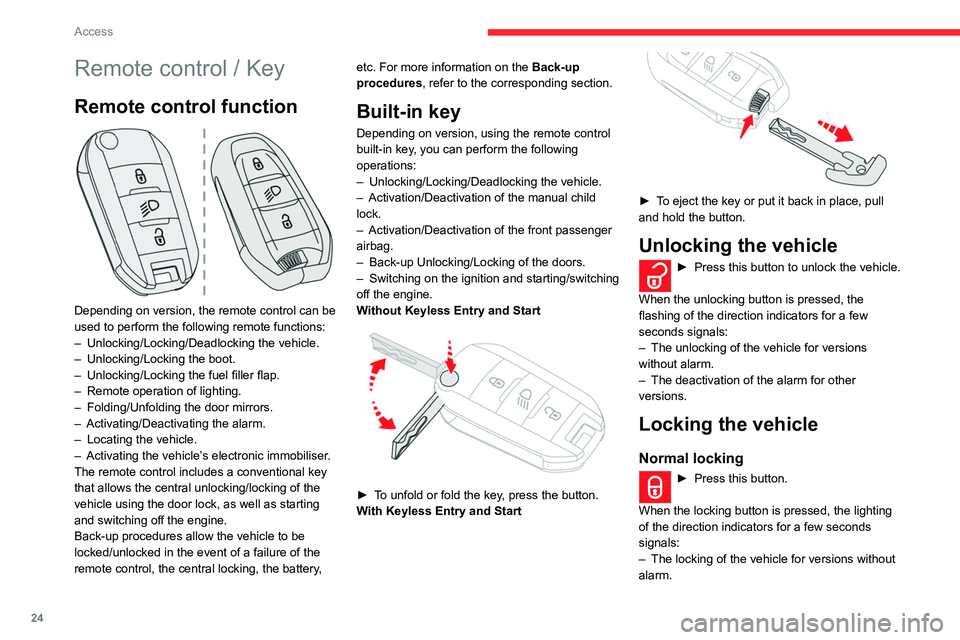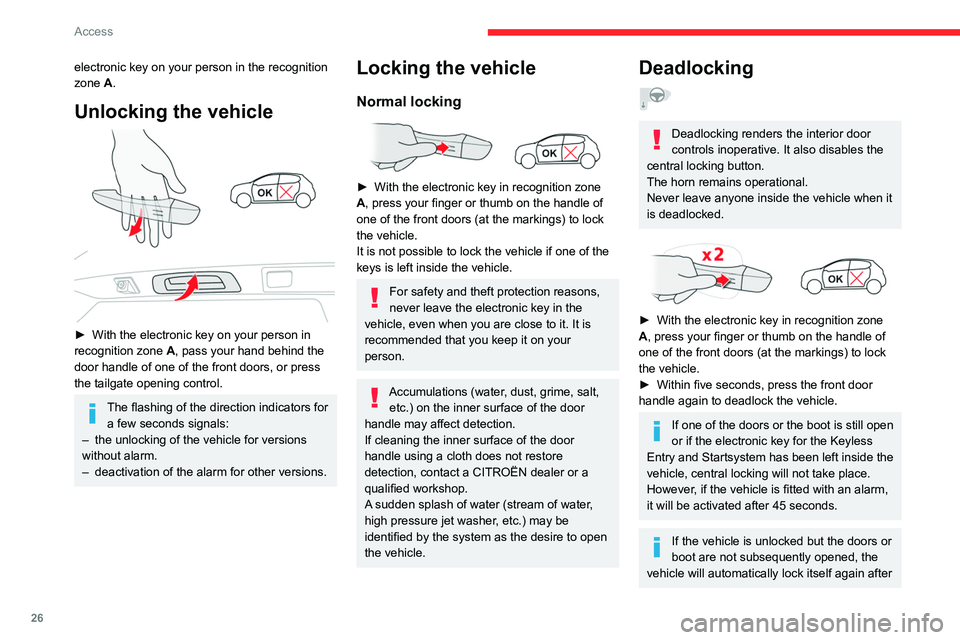ESP inoperative CITROEN C3 AIRCROSS 2023 Owners Manual
[x] Cancel search | Manufacturer: CITROEN, Model Year: 2023, Model line: C3 AIRCROSS, Model: CITROEN C3 AIRCROSS 2023Pages: 244, PDF Size: 7.09 MB
Page 26 of 244

24
Access
Remote control / Key
Remote control function
Depending on version, the remote control can be
used to perform the following remote functions:
–
Unlocking/Locking/Deadlocking the vehicle.
–
Unlocking/Locking the boot.
–
Unlocking/Locking the fuel filler flap.
–
Remote operation of lighting.
–
Folding/Unfolding the door mirrors.
–
Activating/Deactivating the alarm.
–
Locating the vehicle.
–
Activating the vehicle’
s electronic immobiliser.
The remote control includes a conventional key
that allows the central unlocking/locking of the
vehicle using the door lock, as well as starting
and switching off the engine.
Back-up procedures allow the vehicle to be
locked/unlocked in the event of a failure of the
remote control, the central locking, the battery, etc. For more information on the Back-up
procedures, refer to the corresponding section.
Built-in key
Depending on version, using the remote control
built-in key, you can perform the following
operations:
–
Unlocking/Locking/Deadlocking the vehicle.
–
Activation/Deactivation of the manual child
lock.
–
Activation/Deactivation of the front passenger
airbag.
–
Back-up Unlocking/Locking of the doors.
–
Switching on the ignition and starting/switching
off the engine.
W
ithout Keyless Entry and Start
► To unfold or fold the key, press the button.
With Keyless Entry and Start
► To eject the key or put it back in place, pull
and hold the button.
Unlocking the vehicle
► Press this button to unlock the vehicle.
When the unlocking button is pressed, the
flashing of the direction indicators for a few
seconds signals:
–
The unlocking of the vehicle for versions
without alarm.
–
The deactivation of the alarm for other
versions.
Locking the vehicle
Normal locking
► Press this button.
When the locking button is pressed, the lighting
of the direction indicators for a few seconds
signals:
–
The locking of the vehicle for versions without
alarm.
– The activation of the alarm for other versions.
If one of the doors or the boot is not fully
closed, the locking does not take place.
However, if the vehicle is equipped with the
alarm, it is fully activated after about 45
seconds.
If the vehicle is unlocked inadvertently and
there is then no action on the doors or boot,
the vehicle will automatically lock itself again
after about 30 seconds. If the alarm was
activated beforehand, the alarm is reactivated
automatically.
Locking also deactivates the central locking
button, located on the dashboard.
Deadlocking
Deadlocking renders the interior door
controls inoperative. It also disables the
central locking button.
The horn remains operational.
Never leave anyone inside the vehicle
when it is deadlocked.
► Press the locking button again within 5
seconds to deadlock the vehicle (confirmed by
the temporary lighting of the direction indicators
for versions without alarm).
Page 28 of 244

26
Access
electronic key on your person in the recognition
zone A.
Unlocking the vehicle
► With the electronic key on your person in
recognition zone A
, pass your hand behind the
door handle of one of the front doors, or press
the tailgate opening control.
The flashing of the direction indicators for a few seconds signals:
–
the unlocking of the vehicle for versions
without alarm.
–
deactivation of the alarm for other versions.
Locking the vehicle
Normal locking
► With the electronic key in recognition zone
A , press your finger or thumb on the handle of
one of the front doors (at the markings) to lock
the vehicle.
It is not possible to lock the vehicle if one of the
keys is left inside the vehicle.
For safety and theft protection reasons,
never leave the electronic key in the
vehicle, even when you are close to it. It is
recommended that you keep it on your
person.
Accumulations (water, dust, grime, salt, etc.) on the inner surface of the door
handle may affect detection.
If cleaning the inner surface of the door
handle using a cloth does not restore
detection, contact a CITROËN dealer or a
qualified workshop.
A sudden splash of water (stream of water,
high pressure jet washer, etc.) may be
identified by the system as the desire to open
the vehicle.
Deadlocking
Deadlocking renders the interior door
controls inoperative. It also disables the
central locking button.
The horn remains operational.
Never leave anyone inside the vehicle when it
is deadlocked.
► With the electronic key in recognition zone
A , press your finger or thumb on the handle of
one of the front doors (at the markings) to lock
the vehicle.
►
Within five seconds, press the front door
handle again to deadlock the vehicle.
If one of the doors or the boot is still open
or if the electronic key for the Keyless
Entry and Start
system has been left inside the
vehicle, central locking will not take place.
However
, if the vehicle is fitted with an alarm,
it will be activated after 45
seconds.
If the vehicle is unlocked but the doors or
boot are not subsequently opened, the
vehicle will automatically lock itself again after
about 30 seconds. If the vehicle is fitted with
an alarm, it will be reactivated automatically.
As a safety measure, never leave the vehicle, even for a short time, without
taking the Keyless Entry and Start system’s
electronic key with you.
Be aware of the risk of theft of the vehicle if
the key is present in one of the defined areas
while the vehicle is unlocked.
To preserve the battery charge in the electronic key and the vehicle's battery,
the "hands-free" functions are set to
hibernation mode after 21 days without use.
To restore these functions, press one of the
remote control buttons or start the engine with
the electronic key in the reader.
For more information on starting with the
Keyless Entry and Start system, refer to the
corresponding section.
Electrical interference
The electronic key may not operate if
close to certain electronic devices such as
telephones (switched on or on standby) or
laptop computers, strong magnetic fields, etc.